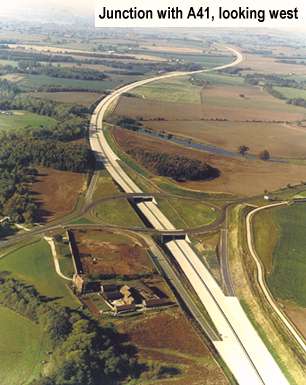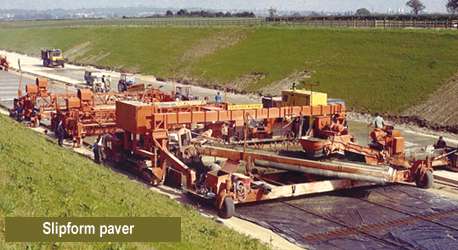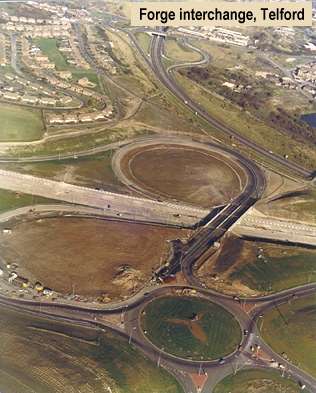History and Background


Two roads of major historic importance traverse the area within which the M54 was built. These are the A5, Watling Street, which was part of the network of military roads built by the Romans in C.40 AD. The Watling Street connected Rochester in Kent to Wroxeter in Shropshire. The other road which came to prominence in the early nineteenth century was the A454/A41/A5, Birmingham to Holyhead Turnpike much of which was built by Thomas Telford in the early 1800's. Both these roads became trunk roads. Prior to the completion of M54 these roads carried heavy volumes of traffic particularly commercial traffic between England and the seaport of Holyhead for Ireland. The roads were, and largely still are, narrow, tortuous and pass through many rural towns and villages. The initial aim of M54 was to take the majority of long distance and commercial traffic off the two trunk roads.
In the early 1960's Government announced an intention to establish a new town in the area around Dawley in Shropshire with twin objectives to improve employment availability in South Shropshire and to provide accommodation and services for population overspill from the West Midland Conurbation. Two major policy decisions in the mid-sixties affected the Dawley development, vis:
the proposed boundaries of Dawley New Town were extended northwards to encompass the existing towns of Oakengates and Wellington and the enlarged proposals were re-named Telford New Town.
the business and industrial attraction of the New Town would be enhanced by the provision of appropriate direct access to the national motorway network (i.e.M6).
Initial planning of the New Town was based on a target population of 225,000 in 1991 of which 136,000 would be overspill from the West Midlands. In 1967 Freeman Fox, Wilbur Smith Associates (FFWSA) were invited by the Ministry of Transport's, Midland Road Construction Unit (MRCU) to investigate and report on the impact of the New Town proposals on traffic demand between the New Town and Wolverhampton and the best highway solution to meet this demand. In 1968 FFWSA submitted their Traffic Report which predicted a demand of 75,000 p.c.u/day by 1990 and a need for a dual 3-lane motorway. The report identified two corridors for a new motorway and a third option upgrading existing roads.
- the A5 Corridor to M6 South of Gailey (J12)
- a new Corridor to M6 North of Laney Green (J11)
- upgrade existing A5 to full dual carriageway grade separated standards together with improvements to A41 and A464 trunk routes.
Route Location and Engineering Design
Initial route studies followed the standard practice of identifying technically feasible lines within the corridors; carrying out all the appropriate consultations and investigations relating to these lines; establishing capital costs of the alternatives and their economic ranking, using recently introduced procedures for economic evaluations.
Construction
The first section of M54 to be built was the Wellington By-pass. This was built between 1973-1975. The Contractor was M. J. Gleeson Ltd and the designer the Staffordshire Sub-Unit of MRCU. There were elements of the design which left much to be desired. The bridges in particular were poor, both from the point of view of constructional detail and aesthetics. The specification used for the sub-base was inappropriate. Build quality was also poor with the carriageway starting to break up after only two years. This was not helped by the decision to go for a choice of flexible or rigid construction in the tender. MRCU H.Q. had made strenuous efforts to have the rigid option dropped due to high incidence of old mine workings along much of the route. Short term economics at Marsham Street and the Treasury once again prevailed. Over the fifteen year period post opening, almost all the original concrete carriageway had had to be replaced. The whole length has now been covered with H.R.A. It also has to be said that relationships between the Contractor and the Resident Engineer during the contract were not good.
The 30km length of the Telford-M6 section M54 excluding Wellington By-Pass, was divided into four contracts with a fifth contract being let for the Forge Interchange with the Telford Town Centre. All sections were designed by Sir Owen Williams and Partners.

The first of the four main contracts to be let was Contract 2, Donington. The Contractor was R M Douglas Construction Ltd. The carriageway was of rigid (concrete) construction laid using a brand new fixed form paver fondly named 'the orange blossom special' because of its bright colour. The two year contract was completed in only 18 months. This was because the first season starting in February 1981 was very dry and all the earthworks and much of the bridgeworks were completed by the autumn. The roadworks followed at a similar pace and the contract completed in Jun 1982. R M Douglas provided an experienced and highly competent team which did much to produce a very satisfactory outcome. The only problem, if indeed it was a problem, of finishing 6 months early was the pressure it put on the other 3 contracts to do likewise. Unfortunately the weather was not so kind over the ensuing 2 years.
The second contract to be let was Contract 1, Shifnal. The Contractor was A Monk & Co. Again, the carriageway was of concrete construction laid using a slip-form paver. A major feature of this contact was the use for the first time in UK of a pulverised fuel ash/ordinary portland cement (pfa/opc) blend being used in concrete. The specification was written by TRRL who also monitored the work on site. It proved to be a very successful experiment and eventually lead to the widespread use of the pfa/opc blend being specified as a standard.
The third contract was Contract 3, Codsall. The Contractor was Alfred McAlpine & Son (Southern) Ltd. Like Contract 1, the Contractor won the contract with a rigid carriageway bid. The concrete again being laid with a slip-form paver. Further pfa/opc blends were used in the concrete mix. This contract traversed the Big Wood in Chillington Park where very extensive environmental and visual screening works were carried out.

The fourth, and largest contract to be let was Contract 4 (Essington). The contractor was Tarmac Civil Engineering Ltd (now Carrilion Construction). The carriageway construction was of flexible (HRA wearing course) construction – this being the cheapest price in this instance. The National Trust property of Moseley Old Hall had to be protected on its north and west sides by a huge earth bund. Much of the material coming from the old colliery waste tops at nearby Hilton Main Colliery. Colliery waste was used extensively elsewhere in the contract. The free-flow interchange with M6 had to be very carefully planned to avoid disruption of flow on M6. It has to be said here that opposition from Staffordshire County Council caused the works to be delayed longer than necessary and for the works to cost considerably more than envisaged. The County Council insisted on temporary roads being provided on both sides of the M6 to enable some local traffic to continue using a side road during the works. In the event this local traffic found alternative routes to avoid the delays. Politics overruled common sense! The completion of this contract obviously dictated the opening of the whole length (it was not possible to open individual sections early due to the junction placements), so pressure was (gently) applied to the Contractor. Despite some small efforts by Neville Simms – later Sir Neville, to have the contract accelerated – (no doubt to make more money for Tarmac (now Carrilion Construction)) the contract was completed (almost) on time.
The final decision to build M54 immediately lead to a rapid increase in the development of Telford New Town. This applied also to the Town Centre which was planned as a major regional shopping centre. Telford Development Corporation (TDC) requested Department of Transport to provide an all-turns interchange between M54 and the Town Centre at Forge. TDC agreed to pay the cost of designing and building the interchange. As a result orders were published, a public inquiry held, orders made and a contract let in a very short space of time. The contract was awarded to Norwest Holst who completed the works within 18 months and this was opened in time to coincide with opening of the whole length of M54 between Telford and M6.



